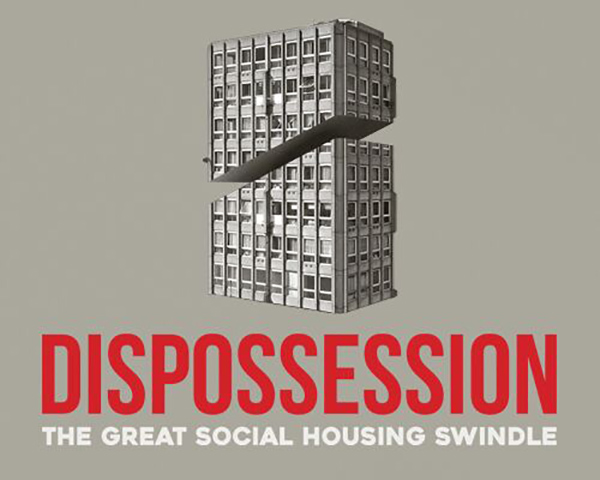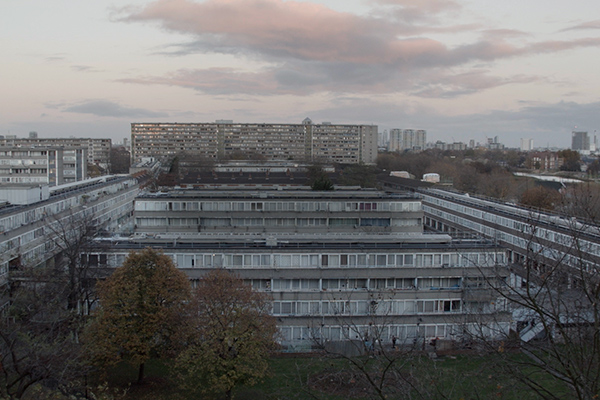You are viewing 1 of your 1 free articles
A review of the film Dispossession
A new film about housing and regeneration raises important questions, but also hits some wrong notes, says Jules Birch
Dispossession: The Great Social Housing Swindle is an important film that arrives at an even more important moment for social housing.
Even before the Grenfell Tower fire it would have posed vital questions about the speed at which we are running down the stock of social rented homes. In the wake of that awful night in June they have become existential ones about the way we house our poorest communities.
The documentary by Paul Sng tells the story of what’s happened to social housing since the introduction of the Right to Buy turned expansion into decline in the late 20th century and especially since regeneration of existing estates became a contentious issue in the early 21st century.
I finally caught up with it this week but there are plenty more screenings in cinemas and other venues around Britain over the next few months.
View the trailer for the film below
Narrated by the actor Maxine Peake, it tells a story that will not be new to people who know housing but may well be to a more general audience.
It’s about how we got from the Bevan and Macmillan building booms via the Thatcher property owning democracy and Tony Blair’s ‘no forgotten people’ speech on the Aylesbury Estate to the demolition and diaspora of Heygate.
But where do you pin the blame for all that? That’s the argument raging across London between Labour councils that see themselves as pragmatically achieving the best outcomes they can for their communities and a burgeoning protest movement that condemns what it sees as neo-liberal collaboration with the market and Tory central government.
“It tells a story that will not be new to people who know housing but may well be to a more general audience.”
For protestors, estate regeneration is a process by which the poor are cleared to make way for homes for the rich. For supporters, councils have to do the best with what they have and private investment is a way to increase affordable housing for everyone.
And that is of course just the most audible part of a bigger debate about the nature and purpose of social housing and what the role of social landlords should be in a commercial world.
Dispossession does not claim to be neutral in this. Watch the opening and closing scenes on the Cressingham Gardens Estate in Lambeth and it’s hard to disagree that something important is being lost in the service of the market.
“For protestors, estate regeneration is a process by which the poor are cleared to make way for homes for the rich.”
As one resident puts it: “They told us ‘nothing will happen without your approval’. Well that was lie number one and it’s never changed.”
However, the film also hits some wrong notes along the way. Most glaringly, within the first three minutes we are told that “at the beginning of the 1980s, 42% of the population lived in social housing. Today that figure has fallen to less than 8%.”
I’ve seen this comparison before on social media and I’m not sure where it comes from but it is a factoid twice over.
Except in Scotland, where more than half of the population lived in council housing in the early 1980s, social housing never reached those levels in Britain.
In 1981, according to the census of that year, just under 33% of the population lived in social housing. The only way I can make sense of the 42% figure is if it is for all rented housing, social and private combined.
Worse still, the “less than 8%” figure for now is only true if you do not count the other 10% of us that live in housing association homes and you regard stock transfer as privatisation. Otherwise the real figure for social housing in England, according to the recent English Housing survey, is 17%.
If such exaggeration is unnecessary (the real decline of social housing is shocking enough on its own), the film’s portrayal of the estates at the centre of regeneration battles in London in the last few years is undeniably powerful.
The segments on Heygate and Aylesbury in Southwark, Balfron Tower in Tower Hamlets and Cressingham Gardens are perhaps obvious choices but they also capture the sense of waste and powerlessness felt by residents.
Anyone who does not know the stories already will come away bewildered at what has happened. Anyone who does will wonder whether they have been looking at the wood or the trees.
“The film also hits some wrong notes along the way.”
How could the estates be demolished or emptied of residents against their wishes? Why have Labour councils and housing organisations seemingly been so desperate to drive the process through?
These are vital questions but we never get to hear the landlords’ side of the story, except in clips of council meetings. For me, that leaves the film with blank spaces where some of the main characters should be.
It also left me wondering why there were only passing references to similarly controversial estate regenerations by Tory councils such as Barnet and Hammersmith & Fulham.
And the film might have made the point that some of the same issues about councils ignoring local communities and homes being demolished rather than refurbished arose when slums were being cleared to make way for council estates in the first place.
“We never get to hear the landlords’ side of the story.”
I’m assuming that Southwark and Lambeth councils and Poplar Harca declined to put anyone up for interview, but the net result is that we are left guessing as to why the landlords took the decisions they did.
However, that criticism could just as easily be turned around: if the councils and social landlords involved are so convinced that they are acting in everyone’s best interests, why were they not prepared to justify their decisions in front of the camera and what have they got to hide?
Maybe they assumed that the film would take a negative view of all regeneration and so there was no point in taking part but in the wake of Grenfell it leaves them looking badly out of touch.
That point is amplified by the fact that Scotland’s first minister Nicola Sturgeon does appear in the segment of the film about the regeneration of parts of Glasgow.
While she blames her Labour predecessors for some of what has gone wrong, that means the film also looks at some of what has gone right and presents a more nuanced picture of regeneration in the city that looks beyond social housing to the community as a whole.
The same is true of the segment that looks at the St Ann’s Estate in Nottingham, which is both an exploration of the stigmatisation of social housing and social tenants and a celebration of the sense of community that exists in spite of it.
“Where the film works best is in showing the impact of all that on the lives of people on social housing estates."
Add a brief look at the potentially devastating impacts of the Housing and Planning Act and that is huge amount of material to pack in to 82 minutes of documentary.
At times I was left wanting more interviews with residents and fewer opinions from a large cast of talking heads.
However, by the end that also gives space for discussion of the broader issues, with some context about the financial pressures facing local authorities and the choices made by central government to subsidise housing via housing benefit rather than investment.
That’s important but where the film works best is in showing the impact of all that on the lives of people on social housing estates.
Paul Sng has previously written and directed a documentary about the Sleaford Mods and has another coming up on Poly Styrene.
He set up his production company in 2015 “to explore the lives and works of individuals who have been neglected, marginalised or misrepresented in mainstream media”.
Dispossession succeeds in that and it gives social housing residents a voice at exactly the time when they most need to be heard.
If you work in housing, and especially if you work in regeneration, the film will challenge you with some awkward questions about the work you do. Which is exactly why you should go and see it.
Jules Birch, award-winning blogger










